© 2008 Alan Levine. The text of this article is licensed under the Creative Commons Attribution 3.0 License (http://creativecommons.org/licenses/by/3.0/).
EDUCAUSE Review, vol. 43, no. 5 (September/October 2008)
The NMC Campus
The New Media Consortium (http://www.nmc.org/) Campus in Second Life represents the largest educational project in any virtual world, comprising the efforts of well over 120 institutions. The NMC Campus landmass includes 91 sims (islands) that the NMC owns/manages as the NMC Campus, plus another 46 that represent the work of leading educational organizations that have chosen to collocate with the project. Our most recent metrics measure about 1,500 unique visitors a week to the 75 main sims on the NMC Campus, with an average visit duration of 60 minutes.
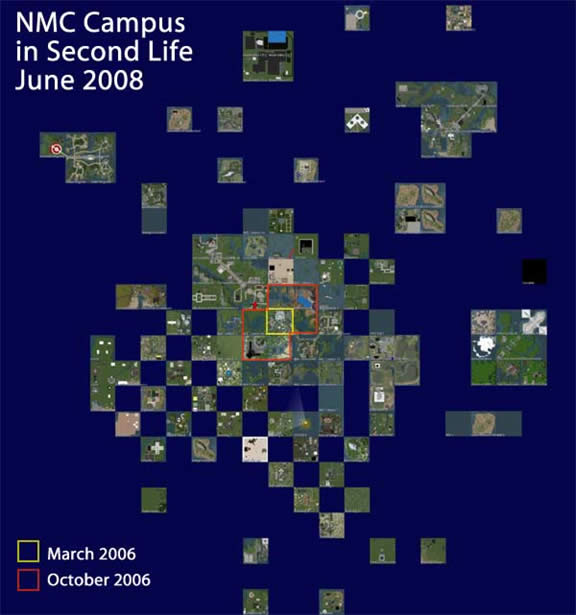
A Little History…
Through a series of hosted activities, events, performances, and outreach to the educational community held since our start in January 2006, the NMC Campus has attracted more than 9,000 members in its Second Life community, counting the membership of in-world groups and self-selected membership via our website. Our entire history and ongoing activities are documented at the NMC Campus Observer (http://sl.nmc.org/) and the NMC Campus Wiki (http://sl.nmc.org/wiki).
The NMC Campus is an experimental effort developed to inform our work in educational gaming (http://www.nmc.org/initiatives/educational-gaming). The NMC’s interest in gaming dates back to 2005, when the NMC Regional Conference at Yale University featured an educational gaming track, with every session standing-room-only. The 2006 Horizon Report (http://www.nmc.org/pdf/2006_Horizon_Report.pdf), published in January 2006, listed educational gaming as one of the featured topics, and soon after, the NMC made the decision to create a space for experimentation in virtual spaces.
A search began for suitable platforms, with a special interest in massively multi-player environments. The NMC chose Second Life as the platform because of its free access and already substantial user community of nearly 150,000 at the time (Second Life now has more than 14 million residents). Our goal was to create an immersive 3D virtual environment in which higher education and museum professionals could interact, collaborate, and experiment. We hoped to provide a low entry threshold for newcomers while simultaneously exploring the boundaries of what is possible.
With input from our membership, our plans (put out as an RFP) called for a virtual campus to be created including a library, large event amphitheater, classrooms, and a world-class museum. The original NMC Campus, a single 256x256m sim, was developed for us by Electric Sheep Company.

The bulk of the work on the original NMC Campus was completed on April 20, 2006, and the moment was marked with an open house attended by more than 150 people. Graduate and other classes began being held in the space soon after. These and a variety of other events, meetings, and tours were used as opportunities to experiment with processes and technologies to determine the best ways to support the space and the people who use it. The official opening of the NMC Campus was marked by a Real Life/Second Life event (http://sl.nmc.org/2006/06/12/cleveland-live/) on June 9, 2006, at the NMC Summer Conference. We started running open public events with Artists on the Green (http://sl.nmc.org/2006/08/01/artists-on-the-green/), an art show and panel discussion that fostered a long-standing, powerful connection with the community of artists in Second Life.
NMC Virtual Worlds
The NMC Campus in Second Life is part of our broader NMC Virtual Worlds initiative (http://virtualworlds.nmc.org/). In this program, launched in January 2007, our highly experienced staff members provide a suite of services, including customized development and design of unique virtual environments, event support for educational organizations, and management of an ever-growing list of specialized educational communities where educators can make a smaller step into virtual worlds by leasing property (http://virtualworlds.nmc.org/services/). Current projects are listed in our portfolio (http://virtualworlds.nmc.org/portfolio/).
Operating successfully as a sustained cost-recovery effort, NMC Virtual Worlds has been able to give back to the educational community by sharing, as open-source content, what we have created for our projects, including amphitheaters, module building units, avatars, furnishings, and science equipment.. These are available on our Learning sim (http://slurl.com/secondlife/Learning).
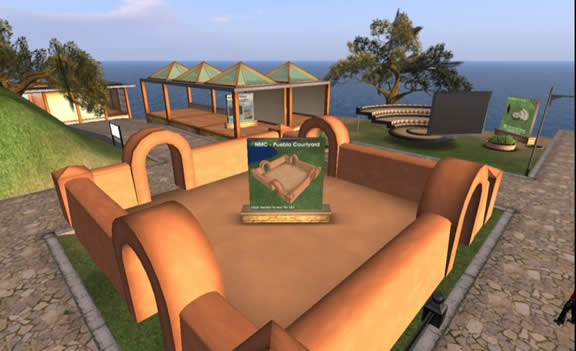
Support for Educators
The NMC actively supports education and the arts through its high-quality academic meetings and research and its sponsoring and showcasing of the finest Second Life arts and artists. The NMC provides educators with (1) a variety of free or low-cost options for places to learn, teach, and experiment, (2) high-end, custom development services, and (3) showcases for exemplary practices.
NMC Virtual Learning Prizes
In May 2008, the NMC announced $100,000 in Virtual Learning Prizes (http://www.nmc.org/virtual-learning-prize), via an open competition for ideas to be created in virtual worlds. Winning submissions receive $5,000 in cash stipends and development services from NMC Virtual Worlds. The first round of winners was announced in July 2008 (http://virtualworlds.nmc.org/2008/07/09/virtual-learning-prizes-awarded/).
NMC Orientation
Listening to feedback from our community, we created NMC Orientation (http://slurl.com/secondlife/NMC%20Orientation) as an alternative to the public Second Life Orientation Island, which confuses or drives away many new users. With custom web server code that accesses the Second Life Registration API, we are able to provide educators with an avatar account-generation form on the NMC website (http://sl.nmc.org/join)so that when new users enter Second Life for the first time, they end up at NMC Orientation.

Modeled by our builders as an homage to both the San Francisco home of Linden Lab (the creators of Second Life) and the birthplace of the NMC, the island for NMC Orientation features four levels: a quick orientation for new users; an in-depth orientation to Second Life skills; an orientation to Second Life culture; and a special orientation for educational uses and practices. Unlike the mainstream Second Life Orientation Island that most users go through only once, with no option to return, the island for NMC Orientation is designed as a place that a user can visit over and over as the need for more advanced learning arises. The Mission District section features tutorials on advanced topics; the Pier of Culture explains Second Life concepts such as “griefing,†“grey goo,†and “being Ruthedâ€; and the Educators Orientation offers resources and topics that educators cite as important to know in using Second Life. A replica of the Golden Gate Bridge offers a path to Ars Simulacra, a rotating showcase for top artists in Second Life.
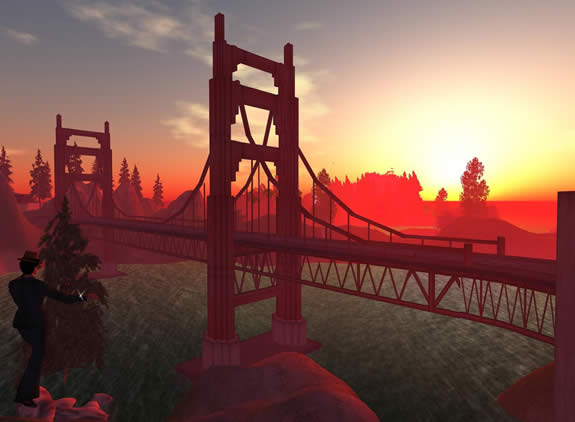
Photo: Torley Linden
Since the launch of NMC Orientation in July 2007, over 3,200 accounts have been created here. Our stats show an average, in 2008, of more than 360 new accounts created each month (http://sl.nmc.org/reg-stats.php). In April 2008 Steve Hornik, an accounting professor at the University of Central Florida, brought 200 new students into Second Life via our registration system, and he plans to bring in an additional 900 students in September for his large lecture class in financial accounting (http://sl.nmc.org/2008/08/12/teaching-accounting-in-sl/, http://www.mydebitcredit.com/2008/08/26/900-avatars-oh-my/).
Educational Communities
The NMC Educational Communities (http://www.nmc.org/pdf/edu_communities.pdf) offer organizations the opportunity to start projects or research in virtual worlds by leasing a plot of land for as little as $100 a year. Each community is limited to bona fide educational institutions and features a unique atmosphere with a collection of five shared facilities located in a common “quadâ€: an amphitheater, a classroom, a conference room, a gallery for showcasing student projects, and a resource center stocked with free items.
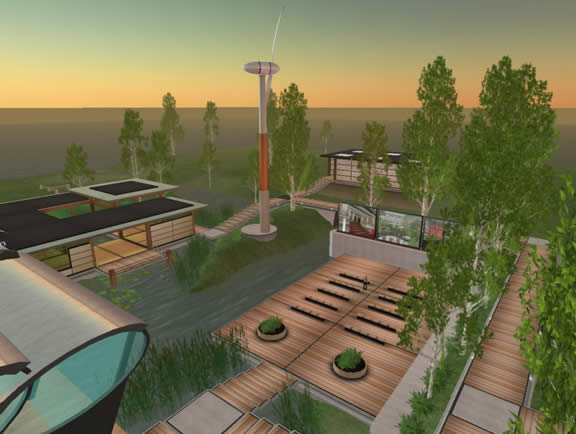
Teachers Buzz
To expand our connections in the educational community, in August 2006 the NMC launched the NMC Campus Teachers Buzz Sessions (http://sl.nmc.org/wiki/Teachers_Buzz_Session) as open, conversational meetings for anyone interested in Second Life for teaching and learning. The sessions were held every two weeks for topical discussions, field trips, and demos. Even though these were successful events, the Teachers Buzz Sessions ended in April 2008 to allow us to focus on new programs. At least two other similar series of meetings are now held regularly in Second Life.
NMC Labs
As another resource, the NMC offers open access to NMC Labs (http://slurl.com/secondlife/NMC%20Labs), a full sim serving as a sandbox where educators can practice building and scripting in a safe environment.
Annual Survey of Educators
To learn more about educators in Second Life, the NMC conducts a yearly survey and shares the results under a Creative Commons license (http://www.nmc.org/surveys). The 2008 NMC Survey of Educators in Second Life collected responses from more than 350 educators; results will be published on the NMC website in early September 2008.
Large-Scale Events on NMC Campus
Our first large-scale event was the Symposium on the Impact of Digital Media (http://sl.nmc.org/wiki/Impact_of_Digital_Media_Symposium), held in October 2006 and attended by more than 1,300 people over eleven days. The event featured a series of keynotes, panel sessions, art shows, storytelling sessions, and music performances. Highlights included a presentation by Howard Rheingold (http://sl.nmc.org/wiki/Rheingold_Presentation) and the press conference, streamed via video, of the MacArthur Foundation’s announcement of the $50 million of funding for digital media projects (http://sl.nmc.org/2006/10/19/macarthur/).
Our experiences from this and many other events eventually led to the construction of the NMC Conference Center (http://slurl.com/secondlife/NMC%20Conference%20Center/12/28/23/), a full-featured sim devoted entirely to hosting academic meetings. The NMC Conference Center is now the home of the NMC’s long-standing series of Online Symposia. To date, the NMC has hosted three major events there:
- Symposium on Creativity in Second Life, August 12–18, 2007 (http://www.nmc.org/symposium-on-creativity)
- Symposium on the Evolution of Communication, December 4–5, 2007 (http://www.nmc.org/2007-fall-virtual-symposium)
- NMC Symposium on Mashups, April 1–3, 2008 (http://www.nmc.org/2008-spring-symposium)
The NMC Conference Center is also available to any educational institution for its own events and has been used widely by the community. The site features venues for large keynotes, an innovative “presentation in the round†coliseum for sessions, small rooms for breakouts, an open display area for exhibitions, and free resources for educators.
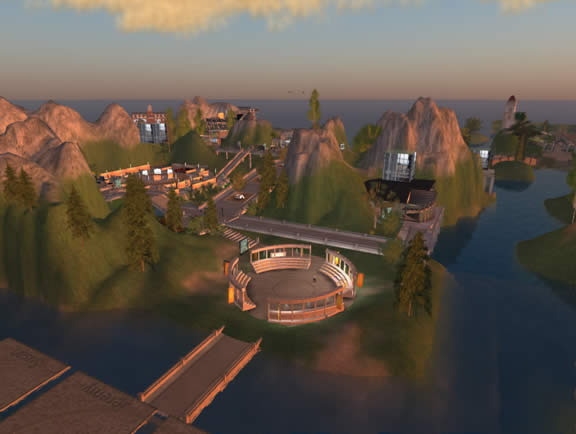
Photo: Torley Linden
Art and Performances on the NMC Campus
With creative expression being a major focus of the NMC, we have extended that effort into Second Life, partly by choosing the aesthetics and design of our virtual presence and also by being a place where art is showcased and made. We have nurtured and provided canvases for some of the most creative Second Life artists:
- DanCoyote Antonelli’s choreographed performances of the ZeroG SkyDancers, which appeared numerous times at the NMC Campus (http://sl.nmc.org/tag/zerog/)
- The April 2007 performance by Red {an orchestra}, which was streamed into two locations at the NMC Campus and at the OneCleveland sim (http://sl.nmc.org/2007/04/15/red-performance/)
- Kiss The Sky, an exhibit of Hyperformalism art by thirteen different Second Life artists (http://sl.nmc.org/2008/05/15/kiss-the-sky/)
- The Show Must Go On!, a performance of live vaudeville (http://sl.nmc.org/2007/08/03/vaudeville/)
- The Wall V-2, a dance and visual interpretation of Pink Floyd’s The Wall produced by CARP (Cybernetic Art Research Project), shown at the NLC Campus twice a week during the summer of 2008 (http://sl.nmc.org/tag/thewall/)
The Kirsti Aho Museum (http://slurl.com/secondlife/NMC%20Campus/115/88/25/) on the NMC Campus (http://sl.nmc.org/2008/01/24/aho/) is one of the premiere showcases of art anywhere in Second Life, thanks to the curatorial direction of Tayzia Abattoir. In January 2008, a new home for the Aho was designed and built by the NMC’s master builder Christopher Holden. The permanent collection showcases virtual art forms and includes sculptures of all kinds, interactives, prim-based recreations of real-life art, computer-mediated drawings and paintings, scripted and computer-generated art, virtual photography, and machinima.
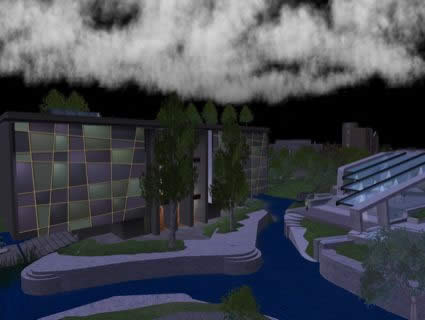
The NMC has dedicated three full sims to virtual and interactive art: NMC Campus West, Ars Simulacra, and NMC Arts Lab.. NMC Campus West is the home of the Aho Museum and its permanent collection; Ars Simulacra, an extension of the Aho Museum, features rotating exhibitions from top artists in Second Life; and NMC Arts Lab is a sim devoted to experimental large-scale installations, such as Husk, a current installation by AM Radio. Past installations have included DanCoyote Antonelli’s Full Immersion, the first artwork in Second Life to use the entire 47 million cubic meters of a sim.
The Future
The NMC has focused on understanding the essential characteristics of virtual worlds that can support learning and work. To explore these topics, we’ve organized numerous events and brought together many people in Second Life. NMC Virtual Worlds has supported nearly 125 institutions and has built dozens of virtual campuses and learning spaces.
With the growth of the NMC Campus and the tremendous number of people in the educational community now running their own events, in 2008 the NMC team began to turn to an exploration of newer forms of design, architecture, and experiences that take place in Second Life. We will soon reveal not only an architecture design tool that is going to be of interest to any real-world institution starting a building redesign process, but also more than a dozen new learning spaces and tools. A new literature project promises to offer an intensely immersive journey into a classic piece of writing. In addition, the NMC is actively involved with a number of projects in other spaces, including Wonderland, Lively, and OpenSim.
Stay tuned!
